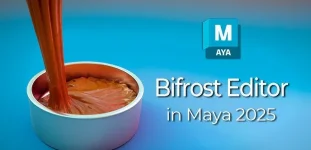yesundercover
10
Rank

Exploring the Latest Features in Autodesk Bifrost 2.12: A Comprehensive Overview
Autodesk's Bifrost 2.12 update introduces several exciting enhancements designed to streamline visual effects workflows and improve performance. Bifrost, a procedural framework, offers powerful tools for creating dynamic simulations and visual effects, widely used in 3D modeling, animation, and effects industries. Here’s an overview of what the latest version brings to the table and how it can enhance creative processes.
1. Enhanced Particle Simulation and Dynamics
One of the main highlights of Bifrost 2.12 is its improved particle simulation capabilities. Users can expect more realistic interactions and dynamics in their particle simulations, making it easier to achieve complex effects with enhanced precision. This includes changes to particle shape, motion, and collision dynamics, enabling users to create visually compelling simulations with greater control over individual particles and their behaviors.
2. Better Performance and Speed
Performance improvements are always a welcome update for 3D artists, and Bifrost 2.12 delivers in this regard. The new version has optimized core functions, which helps reduce computation times for large-scale simulations. Faster processing allows artists to iterate on their work more efficiently, reducing wait times and enabling more detailed and intricate designs. This performance boost benefits artists dealing with intensive workloads and complex projects, where even small improvements can make a significant impact.
3. Advanced Material Handling
The 2.12 update also brings advanced material handling options, which means users can apply and control textures and shaders with more flexibility. These updates provide users with improved shading options, allowing them to create materials that reflect light, texture, and environment in more sophisticated ways. For instance, artists can now apply intricate details to textures, providing an increased level of realism to materials and surfaces, which is especially valuable in projects requiring high realism, such as architectural visualizations and CGI.
4. Fluid and Smoke Simulation Improvements
Bifrost 2.12 introduces new parameters and controls for fluid and smoke simulations, a critical aspect for visual effects artists. These improvements offer more granular control over fluid dynamics, such as the ability to fine-tune viscosity, density, and flow rate. These features make it easier to achieve realistic effects, like water movement or smoke dissipation. The new parameters are highly customizable, enabling artists to adjust attributes to match project-specific requirements, giving them control over each element of their simulation.
5. Expanded Graph and Node Functionality
Another notable improvement in Bifrost 2.12 is the expansion of its graph and node functionality. The Bifrost Graph is an essential part of the procedural workflow, and this version introduces new nodes that provide greater flexibility and creative options. With added node functions, users can achieve complex procedural effects without having to rely on third-party plugins or extensive custom coding. This update is especially beneficial for technical artists who rely on procedural generation to create scalable assets and complex animations.
6. Improved Usability and Interface
User experience is a priority in the latest update, as Bifrost 2.12 features a more intuitive interface with streamlined tools. These usability improvements reduce the learning curve for new users and make Bifrost more accessible to artists with varying levels of experience. Autodesk has focused on simplifying tool organization and providing clearer labels, helping artists spend more time on creativity and less time navigating the interface.
7. Expanded Compatibility and Integration
Compatibility is crucial in any software update, and Bifrost 2.12 has been designed to integrate more smoothly with other Autodesk products, like Maya and 3ds Max, and third-party tools. This expanded integration facilitates a more cohesive workflow across different applications, enabling artists to transfer assets and projects between platforms with minimal compatibility issues. As a result, studios working on multifaceted projects can streamline their workflows and collaborate more efficiently across different software environments.
CGPeers Conclusion:
The Autodesk Bifrost 2.12 update brings numerous benefits to digital artists, animators, and technical directors who rely on this powerful tool for procedural effects and dynamic simulations. With enhanced particle systems, improved performance, and advanced material handling, this version is set to elevate the quality of visual effects achievable in Bifrost. The expanded graph functionality and fluid simulation controls further enhance Bifrost's utility, making it a valuable asset for studios looking to optimize their visual effects workflows.
For artists and studios already using Bifrost, this update represents a significant upgrade in capability, while new users will find a more intuitive interface that makes getting started easier. With Autodesk's continued commitment to refining and expanding Bifrost, this tool will remain a strong choice for industry professionals aiming to push the boundaries of procedural modeling and simulation.
Legal Disclaimer:
The articles and content published on this site are for informational purposes only. CGPeers.in does not host, distribute, or claim ownership of any copyrighted material. All content is uploaded by users, and the responsibility for ensuring that the content complies with copyright laws rests with the uploader. By reading or using this content, you agree to do so at your own risk. CGPeers.in, its hosting provider, and its community are not liable for any legal action or claims related to the uploaded material.